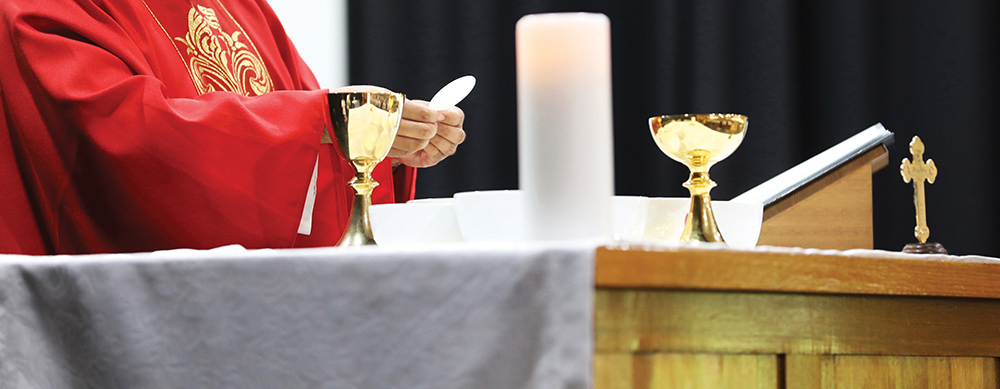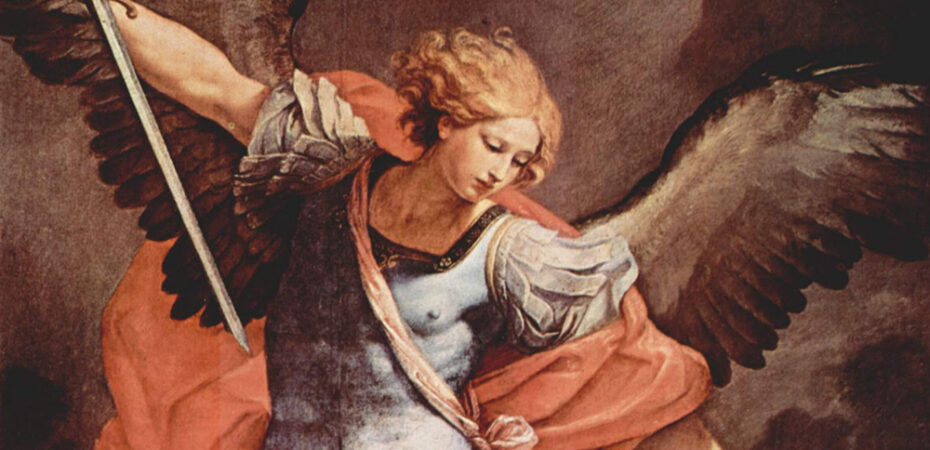Evaluating the Prayer to St. Michael
Where should the prayer be placed?
Father Paul Turner Comments Off on Evaluating the Prayer to St. Michael
St. Michael the Archangel has a well-earned reputation for defending the frail in battle. But he surely never imagined the formation of 21st-century battle lines around a prayer addressed to him.
In recent years, some priests and bishops have reinserted the preconciliar prayer to St. Michael after the celebration of Mass. Concerned about attacks on the Church from within and without — such as the clergy sex abuse crisis and the persistent suppression of evangelization under theocratic governments — some aggravated clergy have decided the time has come to search the liturgical attic for stockpiled weapons of defense. To them, the prayer to St. Michael seems to suit the need.
Pope Leo XIII had already appended a suite of devotional prayers to the end of Mass in 1884, eponymously called the Leonine Prayers. To these, he added the prayer to St. Michael in 1886. At the time, the Italian government threatened the Papal States, and Leo hoped the prayer would help defend the independence of the Holy See. No such political incursion threatens the Vatican City State today, but concern over the Church’s spiritual well-being has raised interest in a prayer composed for the Church’s temporal well-being.
Many people object, particularly specialists in the field of liturgy. The Second Vatican Council’s Constitution on the Sacred Liturgy defended both sound tradition and legitimate progress (cf. No. 23). It called for a revision of the rites of the Mass to clarify their purpose and achieve the participation of the people, and it noted that elements that entered the liturgy over the passage of time but with little advantage were to be discarded (cf. No. 50). These principles led to a spare, focused celebration that highlights the best of the Roman Eucharistic tradition.
The revisers who took up the work that the council mandated recovered many elements of the Mass evident from the early centuries, such as the universal prayer, and removed elements that were later additions, such as the last Gospel. The Leonine Prayers entered the history of the Mass as latecomers, less than a century before the opening of the Second Vatican Council. To be precise, they were not part of the preconciliar missal’s Order of Mass. They were recited afterward. However, visually, aurally and experientially, they seemed part of the same service.
Unsurprisingly, the Leonine Prayers do not appear in the revised Order of Mass in the current Roman Missal. Their omission helped apply the principles of the reform even to the concluding rites, lending more coherence to the flow of the Mass and the transition of the people from worship into service.
Concluding Rites
The concluding rites aim toward the dismissal. According to tradition, the responsibility to dismiss the assembly belongs to the deacon, or, in his absence, to the priest. Deacons act as a kind of prompter throughout the Mass, cueing the postures and gestures of the people. In the past deacons would also announce the dismissal of catechumens preparing for initiation, penitents preparing for reconciliation and energumens preparing for exorcism. Upon their dismissal, these groups accordingly departed.
Prior to the council, after the deacon’s dismissal the ministers and people did not leave immediately. They remained in place to receive the final blessing of the priest, which, surprisingly, followed the dismissal. This sequence probably evolved from a practice of the bishop blessing individuals at their request after Mass. The presider’s blessing entered the Order of Mass, but its placement near the end diminished the force of the deacon’s words. By reordering the sequence of blessing and dismissal, the revised liturgy gives more integrity to this part of the Mass. After the priest’s blessing, the deacon sends the assembly into the world, and they best respond as eagerly and promptly as they do to his other liturgical commands.
Of course, in many parishes, the community then sings a closing hymn, which is not in the rubrics, and which, it could be argued, also steals some integrity from the deacon’s command. The rubrics envision that upon the deacon’s words the ministers lead the way by going forth to put the fruits of the Mass into practice, and to do it immediately, not after singing another song.
If a closing hymn can be added, why not the prayer to St. Michael? In truth, neither practice stands on firm rubrical ground. However, the United States Conference of Catholic Bishops mentions the closing hymn at the end of the book, “Introduction to the Order of Mass: A Pastoral Resource of the Bishops’ Committee on the Liturgy” (Liturgical Press, $29). There the bishops maintain that such music is always an allowable option. Their book is silent, however, about permitting the prayer to St. Michael.

To God the Father
The principal prayers of the Mass are addressed to God the Father. Some few are addressed to Jesus Christ, especially during the Communion rite. The only words addressed to Mary, the angels and the saints are in the penitential act, and only on the days when the Confiteor is chosen. Even there, the words of confession are addressed equally to God the Father and the gathered community of brothers and sisters. The prayers of the Mass are serious business, deep in tradition, rich in theology and persistent in their formation of the People of God. Prayers are generally addressed to the Father, through Jesus Christ, in the Holy Spirit.
To offer a prayer to St. Michael, then, raises some problems. The practice presumes that something more needs to be said, that the Mass has somehow been left incomplete, and that the remedy comes not in another prayer to the Father, but one addressed to an archangel instead. Furthermore, the content of the prayer — and a characteristic of its renewed appeal — is ecclesiocentric, seeking defense of the Church. However, other concerns also plead for attention: victims of national disasters, the proliferation of gun violence, antisemitism, warfare within and between nations, injustices against persons of color, the plight of migrants.
The Universal Prayer
If it seems that these intentions belong best in the universal prayer, that is precisely the point: so does any prayer for the defense of the Church. That is why the universal prayer was restored to the liturgy, so that it could accept the intentions relevant to the time and place. If a parish or a diocese has concerns that the Church needs angelic, exorcistic defense, the intercession of St. Michael can be sought within one of these petitions that conclude the Liturgy of the Word. The universal prayer did not exist when Pope Leo added the prayer to St. Michael, so his choices were limited. Today, the liturgy has a structure within which such concerns can be fittingly addressed by people who have heard the sacred Scriptures, received their inspiration and are lifting their contemporary petitions to God.
A similar direction applies to the tendency to add to the Order of Mass prayers for vocations or for the success of a capital campaign, or even the daily insertion of the Hail Mary or the Anima Christi at some point. Any of these additions will tip the delicate balance that the liturgy strives to achieve in welcoming worshippers to the tables of the Word and the Eucharist. Petitions for an increase of religious vocations, stewardship, devotion to Mary or to the Eucharist are fittingly added to the universal prayer at any Mass.
Vatican Documents
The most important argument against restoring the prayer to St. Michael after Mass is the simplest: The Vatican removed the Leonine prayers, effective on the First Sunday of Lent in 1965. In the instruction Inter Oecumenici, one finds this clear statement: “The last gospel is omitted; the Leonine Prayers are suppressed” (No. 48).
A priest may argue that he is not adding the prayer to the Mass; his community recites the prayer after Mass. But if he is still vested in his chasuble and remains in the sanctuary, it sure looks like Mass.
Several bishops have restored the prayer to Mass throughout their diocese. Bishops oversee the liturgy, so they have authority through it to nurture the spiritual lives of the people in their care. But such an action will cause head-scratching when people read in Sacrosanctum Concilium (Constitution on the Sacred Liturgy) that not even a priest “may add, remove or change anything in the liturgy on his own authority” (cf. No. 22.3), a sentiment repeated in the Code of Canon Law (cf. No. 846.1). A bishop who universally restores the prayer to St. Michael may be communicating an unintended and perilous message to his priests: If you don’t like the liturgy, change it.
The Holy See’s work on the revised Order of Mass is the fruit of careful research, broad vision, faithful courage and love for the future. Those who accepted the task from Pope St. Paul VI crafted a beautiful liturgy. The Mass is fine just as it is. It does not need any fixing.
For some of the priests who lived through the liturgical changes, embraced them and promoted them in service to the Church, the restoration of the prayer to St. Michael may feel like a rejection of principles that they have endorsed throughout their years of ministry. This same feeling may also emerge when a priest who did not live through the conciliar years imports gestures and words that the Church carefully set aside: saying vesting prayers, wearing a maniple, adding Signs of the Cross, prolonging the showing of the host and the chalice, keeping together the canonical digits that have touched the consecrated Host, authorizing ringing the bell at the priest’s Communion, or asking the faithful to kneel at rails for Communion. These and other mannerisms have made some older priests feel at the end of their long careers that their liturgical efforts have been ignored by a new generation. Surely no priest intends to add the prayer to St. Michael in order to disdain the work of his brothers. But to some priests it feels part of a larger narrative, more evidence that their faithful work has gone underappreciated by their own brothers in ministry.
Does It Make a Difference?
Does this little prayer make such a big difference? The Order of Mass establishes a uniformity of practice throughout the Church, so adherence to its structure and components exercises service to the greater good of the liturgy. Faithfulness to its design will also help clarify the purpose of the concluding rites. The people who have just received the body and blood of Christ are sent into the world. They do not pause to add another petition that could have been included more properly in the universal prayer. No, they are sent to proclaim the Gospel and to glorify the Lord by their lives.
Besides, they have just received the Eucharist. There is no more potent defense in spiritual battle, no more powerful exorcism against the forces of sin, no greater presence in all the world than the one they receive in Communion.
St. Michael himself would surely have the faithful go forth immediately from the Mass to face the conflicts of the world armed with the greatest force for spiritual and temporal good: the body and blood of Christ.
FATHER PAUL TURNER is pastor of the Cathedral of the Immaculate Conception in Kansas City, Missouri, and director of the Office of Divine Worship for the Diocese of Kansas City-St. Joseph.
……………………………………………………………………………………………………………………………………………..
Prayer of St. Michael the Archangel
St. Michael the Archangel, defend us in battle. Be our defense against the wickedness and snares of the devil. May God rebuke him, we humbly pray, and do thou, O Prince of the heavenly hosts, by the power of God, thrust into hell Satan, and all the evil spirits, who prowl about the world seeking the ruin of souls. Amen.
………………………………………………………………………………………………………………………………………………





